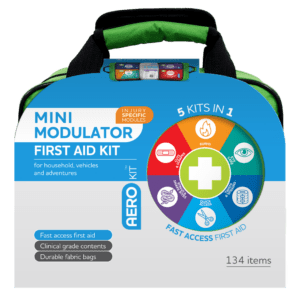AEDs – The What, The Why, The How
February is Heart Research Australia’s RED FEB month. A month focussed on raising awareness of heart disease. Learn more about AEDs in the article below, and how they help in the event of Sudden Cardiac Arrest.
Sudden Cardiac Arrest (SCA) can strike anyone, anywhere at any time. To give the victim the greatest chance of survival it is crucial that the chain of survival is completed. The first link in the chain of survival for a SCA victim is Early Access, checking the victim’s breathing and consciousness and phoning for an ambulance. The second link is Early CPR, effective CPR ensures vital organ function and the sooner it is conducted the greater the chance of survival.
The third link in the Chain of Survival is Early Defibrillation, and the final link is early advanced care. Using an Automated External Defibrillator or AED to complete the chain of survival will provide the victim with the best possible outcome for recovery. A victim’s chance of survival dramatically decreases for every minute without treatment 1. To learn more about Sudden Cardiac Arrest and its impact, read our article, Sudden Cardiac Arrest – The Silent Killer.
What is an Automated External Defibrillator?
An Automated External Defibrillator or AED as it is commonly referred to is a small, often portable device that analyses the heart rhythm of a patient and can provide an electric shock needed for defibrillation of the heart. In doing this, it allows restoration of the normal heart rhythm. The most frequent heart rhythm witnessed during a Sudden Cardiac Arrest is ventricular fibrillation, a type of abnormal heart rhythm. The only treatment to overcome this is defibrillation. Adhesive electrode pads provided with the AED are attached to the victim’s chest to allow the electric shock to travel to the heart. Some AEDs such as the Heartsine 500P also offer additional features, such as the CPR advisor, which analyses the quality of compressions during CPR and provides real time audible and visual feedback on the quality of the compressions. AEDs while sounding complex are a rather simple device to operate, providing minimally trained people with a powerful lifesaving device.
How does an AED work?
An AED is programmed to give both visual and voice prompts, telling and showing the rescuer exactly what to do in an emergency. Rescuers attach adhesive electrode pads to the victim’s chest. With these electrodes attached, the AED will analyse the heart activity and determine if a shockable rhythm is present. The AED will then provide voice prompts to the rescuer, coaching them through the CPR and defibrillation process. If the AED recognises a shockable heart rhythm is present it will ask the rescuer to stand back so the shock can be safely given. Some AEDs are fully automatic and will administer a shock when required by itself. Others require that the rescuer push a button to administer the shock.
The flagship Heartsine 500P includes a unique CPR advisor which captures the impedance change of the heart in an ICG wave form which it uses to count the number of compressions a rescuer administers. It identifies the force at which the compressions are applied, and then provides feedback to the rescuer on the effectiveness of their CPR. Advising them on good compressions or the need to push harder or softer. Effective CPR in conjunction with a lifesaving shock can dramatically increase the chance of survival. Early defibrillation within three to five minutes of Sudden Cardiac Arrest will give the victim a greater chance of survival.
Why purchase an AED?
To provide a Sudden Cardiac Arrest victim with a greater chance of survival, it is important that the chain of survival is completed. AEDs are the third link in this chain and provide the most effective treatment to SCA victims. While CPR ensures that oxygenated blood continues to flow to the brain, defibrillators are required to effectively “jump start” the heart. If early defibrillation is applied there is a significant increase in the chance of survival. A defibrillator will administer a controlled electric shock, to allow restoration of the normal heart rhythm. By providing voice and visual prompts on what to do, the AED provides confidence to any first responder of a Sudden Cardiac Arrest Incident. The Heartsine 500P with its CPR Advisor provides the added advantage of providing guidance on the effectiveness of the CPR being conducted. Effective CPR combined with defibrillation of the heart, further gives the victim a greater chance of survival.
References
- Graham R, McCoy M, Schultz A. Strategies to Improve Cardiac Arrest Survival, A Time to Act. Institute of Medicine Report, 2015.



 Introducing the NEW Mini Modulator - perfectly sized for taking on your next adventure!
Introducing the NEW Mini Modulator - perfectly sized for taking on your next adventure!
